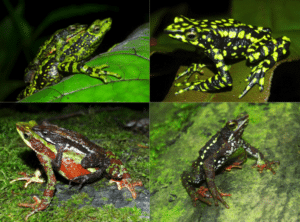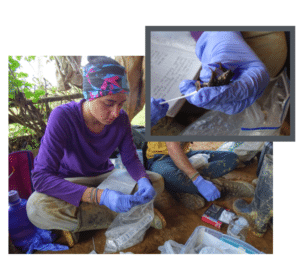
Meet the ‘happy toad’ Atelopus laetissimus, a harlequin toad found on the slopes of the Sierra Nevada de Santa Marta mountains of Colombia. This toad is brightly colored, with an almost comical slow walk and lots of other unique attributes.
But the reason it is delighting scientists and conservationists is its ability to adapt and survive while its relatives are on the brink of extinction.
The 2020 Plant and Animal Sciences SMRT Grant Program co-sponsored by PacBio and the DNA Sequencing Center at Brigham Young University will enable a team of researchers from Colombia’s Universidad de los Andes and Universidad del Magdalena to delve deep into the A. laetissimus genome to discover the secrets of the toad’s evolutionary success.
Watch their outstanding video abstract submission:
The project garnered more than 6,000 votes as part of a video competition, thanks in large part to the science communication chops of its star. Biologist Carlos Guarnizo (@guarnitron) is the founder of Bogota’s Ciencia Cafe, which hosts in-person events as well as online networking and resources on Facebook and Twitter (@CienciaSumerce).
Guarnizo and the rest of his multidisciplinary team hope to gain insights into the basic biology of the colorful toad, as well as its evolution, speciation and adaptation.

Herpetologist and conservationist Vicky Flechas (@vickyflechas) is curious to find out what makes A. laetissimus resistant to the chytrid fungus that is killing so many other frogs and toads locally and globally. Does it have resistance genes, or perhaps anti-microbial skin peptides?
Herpetologist Beto Rueda (@herpetobeto), who lives among the toads in Santa Marta, wants to learn more about their vision, thermal biology, and some of their unique characteristics, such as their potential ability to sense their prey via vibrations, or the male’s ability to survive three months without food while clinging onto a female’s back in a long mating embrace. He is also eager to compare the A. laetissimus DNA and RNA sequences to other harlequin toad species from other altitudes within the unique habitat, which ranges from Caribbean beaches to peaks with permanent snow. This snow-capped mountain range, the Sierra Nevada de Santa Marta, has never been connected to other mountains such as the Andes, so it is host to a variety of unique, endemic species.
Evolutionary geneticist Andrew Crawford (@CrawfordAJ) is fascinated by another of the toad’s unique traits; it is nocturnal, while almost all other toads and frogs in the area are diurnal.
“The toad seems to have gone from nocturnal to diurnal and back to nocturnal,” Crawford said. “It could become a model system for nocturnality across frogs.”
Crawford, a council member of the Vertebrate Genomes Project, and chair of its Amphibians working group, is excited to be able to do the research using HiFi sequencing data.
“Frog genomes are a bit big, and a bit repetitive,” he said. “Some of the assemblies attempted in the past have been so fragmented. But the VGP and the Sanger Institute are getting to nice assemblies, and the foundation of that is PacBio HiFi data.”
Conservation of the species is the ultimate goal. The genus as a whole is endangered; of 97 species, 80% are critically endangered, and the status of many others is uncertain, as they have not been seen for 30 years or more.
Having a high-quality reference genome would also enable the team to do ‘museumomics’ — using stored samples to gain an understanding of species that have gone extinct or are hard to find.
“PacBio will be the salvation of frog genomes,” Crawford said.

We’re excited to support this research and look forward to seeing the results. Thank you to our co-sponsor and Certified Service Provider, the DNA Sequencing Center at Brigham Young University, for supporting the 2020 Plant and Animal Sciences SMRT Grant Program. Explore the 2020 SMRT Grant Programs to apply to have your project funded.
Learn more about using HiFi reads to explore the genomes of plants and animals.